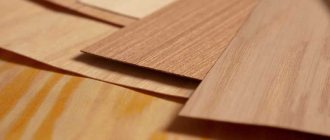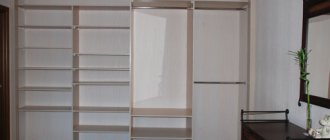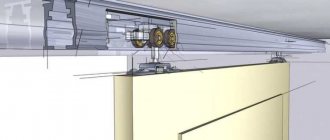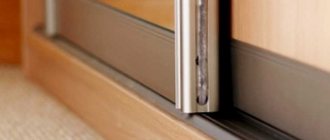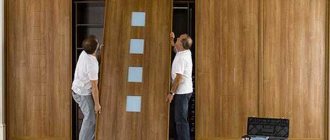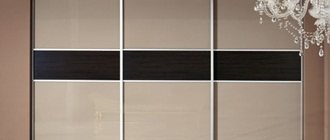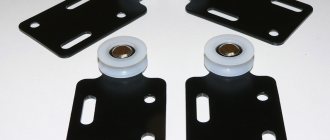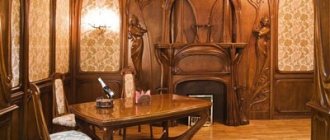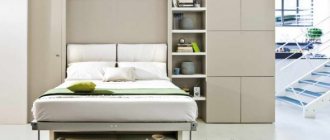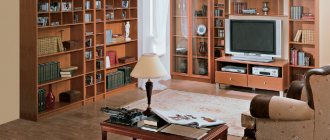Laminated chipboard is the standard material for cabinets
Laminated chipboard (in detail - laminated chipboard) is the most popular and widespread furniture material. It consists of finely crushed wood waste - branches, sawdust, bark, shavings, etc. It is this fact that explains the affordable cost of chipboard.
Chipboards have several significant advantages:
- Attractive appearance. The slab itself is an inconspicuous layer of compressed wood. But it is easy to process, which allows you to create almost any design.
- Mechanical strength. Wood-based materials for making cabinets can withstand external influences and constant loads quite well.
- Low price. The cost is explained by cheap raw materials, as well as simple processing of finished slabs.
Disadvantages of laminated chipboard include instability to liquids (which is why cabinets made of this material are rarely installed in kitchens), instability to construction loads (a screw-in screw instantly destroys the slab), and the impossibility of producing curved and original surfaces. In addition, due to the adhesive contained in the boards, laminated chipboard furniture can release harmful substances into the air. The material does not have an environmental certificate.
MDF
The name MDF comes from the English wording “Medium Density Fiberboard”, which means medium density fiberboard. The manufacturing technology consists of pressing dry small chips at high temperature. Unlike chipboard, no synthetic adhesives are used here. Natural lignin, released at high temperatures of wood, acts as glue. This feature makes MDF an environmentally friendly material. Its cost is higher than that of chipboard, but it is very popular due to its better physical characteristics.
MDF is very durable, furniture made from it is more durable. It is not subject to rotting and warping. That is why MDF is widely used in the manufacture of kitchen sets and bathroom furniture. In terms of resistance to moisture, MDF is superior even to natural wood. The average density allows you to perform carved elements and milling on the surface of the slabs.
MDF - an improved version of laminated chipboard
MDF is also a wood-based panel. But in this case, their basis is wood fibers, which are connected to each other by drying, pressing, and sanding. This increases the number of advantages of the material and makes it more prestigious. The main advantages of MDF include:
- Strength. High resistance to external influences is explained by a special technology for connecting wood fibers.
- Environmental Safety. The material meets all the requirements for the environmental friendliness of wood boards (at the same time, it contains an acceptable percentage of formaldehyde and resins).
- Water resistance. Improved MDF boards are not subject to swelling and withstand moisture.
- Long service life. Furniture made from this material retains its technical and aesthetic characteristics for 15 to 30 years.
If you are wondering what material the cabinet is made of - laminated chipboard or MDF, then the answer lies in the second option. These plates are more resistant to external influences and are completely safe for health. Among their main disadvantages, they include only a predisposition to rapid combustion, as well as a relatively high cost.
Accessories
Furniture fittings can be external (handles, plugs, legs, supports) and internal (hinges, door stops and stops, closers, hooks for hanging shelves, fastening strips, staples). Products of the first group are made from materials with high decorative properties. Internal elements are made mainly of metal: steel, aluminum, various iron alloys.
Instructions for making furniture from chipboard with your own hands for beginners
Furniture manufacturing experts divide fittings into several groups according to their technical function:
- for attaching parts to each other - guides, handles, fasteners, legs;
- rotating mechanisms - hinges, swing devices, bearings;
- transformation mechanisms - recliners, roll-out devices, seat and tabletop lifts.
High-quality modern fittings cost a lot. Its total price can be up to 15% of the cost of the furniture itself. These expenses are justified, since low-budget products quickly become unusable. As a result, the furniture itself has to be repaired, which is not always possible, since screws and self-tapping screws leave mechanical damage in the wood panels.
Guides
Pens
Fasteners
Legs
Loops
Rocking devices
Bearings
Advertisers
Lifts
Veneer is a natural material for your furniture
A relatively new material from which furniture is made is veneer. It represents natural sheets of wood that were obtained during planing. This technology was known back in Ancient Egypt, but it gained particular popularity only recently, when the ergonomic use of natural wood became especially relevant.
The advantages of natural veneer are obvious:
- Appearance. Natural wood always looks several classes higher than its artificial counterparts.
- Absolute environmental safety. Veneer is a block of natural wood that does not emit any harmful substances.
- A wide variety. Veneer is extracted from various types of wood.
- Affordable cost (compared to array). The price is explained by the reduced amount of wood used and its simple processing.
Natural veneer also has a number of disadvantages. The main disadvantage is the material's susceptibility to external influences. Over time, natural wood blocks may lose a number of aesthetic characteristics. Also, a negative feature of the raw material is its heterogeneity - even trees of the same species can differ in shade and pattern. Furniture made from veneer can only be installed in a room whose climatic conditions fully correspond to the specific type of wood.
We are buying a wardrobe. Which material is better?
Sliding wardrobes are beautiful and functional furniture that allows you to conveniently place many things and transform the interior of a room. A huge number of design options allows you to implement any design projects at the best price. On the other hand, buyers often find it difficult to make a decision. The first question that arises when buying a wardrobe is the choice of materials. What do manufacturers offer clients? Which option is the ideal combination of quality and price?
- The most common material from which inexpensive sliding wardrobes are made is chipboard. The boards are made from wood chips that are treated with melamine resin. They can have different shades and textures and combine perfectly with any decorative elements. Most large furniture manufacturers use chipboard (laminate), which has increased strength.
- MDF is another popular material that is made from chip dust. It differs from chipboard in higher quality and costs slightly more. MDF has an impeccably smooth surface; in order to decorate the front of the cabinet, it is not at all necessary to stick a decorative film, you can simply paint it. MDF can be easily milled, and convex and curved structures can also be made from it. It is ideal for implementing complex design ideas.
- Veneer is a panel made of chipboard or MDF, sheathed with a thin layer of natural wood. This material is used for the production of luxury furniture and is quite expensive. Veneer cabinets are durable and elegant in appearance. They will serve their owners for decades, which fully justifies their high cost.
Buyers who want to purchase a high-quality and inexpensive sliding wardrobe are best to choose laminated chipboard or MDF. To save the maximum amount, you should choose not too well-known manufacturers. In this case, you won’t have to overpay for the brand.
Another important issue that worries customers is security. In the production of all of these plates, formaldehyde is used, which begins to decompose over time and can cause harm to health. For the production of furniture, it is allowed to use materials that have a minimum emission value of this substance (E1). A certificate for finished products is provided only if this condition is met. Thus, if the cabinet is purchased from a serious company that has all the necessary documents, it can be used for a long time without fear for your health.
Sliding wardrobes made of chipboard, MDF and veneer can be purchased at. Qualified specialists will help you choose the best material and also offer many design options.
Source: www.yourdom.ru
Natural solid wood is a time-tested material
The most common answer to the question of what material cabinets are made from is natural wood. Not a single innovative raw material can surpass wood in terms of technical and aesthetic characteristics. Pine, beech, oak, and birch are most often used in furniture production. The advantages of these materials are:
- Exceptional security. Natural wood does not contain a single percent of harmful components.
- Attractive view. Cabinets made from solid wood look expensive, stylish and original. Retains appearance for many years.
- Strength. Solid wood furniture is extremely difficult to break or damage.
- Long service life. Cabinets made from natural wood will faithfully serve their owners for 50 and even 100 years.
A separate advantage is the aroma released by natural wood. A pleasant smell quickly fills the room, making the atmosphere more cozy and pleasant. As for the significant drawbacks, there is only one - high cost. At the same time, the price of solid wood furniture is fully paid for by the service life of the product.
Now that you know what cabinets are made of, you can choose the material much faster. If you are looking for furniture for a short period of time (10-15 years), choose products made from MDF. If you are interested in the long life of the cabinet and its complete safety, purchase models made from natural solid wood. Such furniture will become the best decoration of the room and will instantly increase its status several times.
Materials and methods of furniture cladding
Regardless of which board you choose for your future furniture, its final cost will also depend on the material with which MDF or chipboard is lined. Today, the most popular are three options: veneering (veneering), lamination and caching.
Veneering , or in common parlance veneering, is the lining of a slab with a thin cut of natural wood. This method allows you to make the product as similar as possible to furniture made from solid wood. These products will, of course, cost more than laminated ones, but they will look very status and respectable. In addition, the vacuum pressing method allows you to literally wrap the veneer around complex carved parts, which means it gives even more naturalness. However, veneer requires careful treatment and special care, just like wooden products.
Lamination is the application of a composition of paper and polymers to a finished chipboard or MDF board, which, under the influence of high temperature, literally melt into the surface of the material, simultaneously acquiring the desired texture. This method of cladding is considered optimal in terms of price-quality ratio, because is not afraid of moisture, sun, temperature changes and retains its original appearance for many years.
Caching , unlike lamination, involves the use of glue. That is, a finished film with the desired texture is glued onto an array of MDF or chipboard. This method is the least expensive of those listed, but also not the most reliable. This cladding is much softer than laminate, which means it is not as resistant to mechanical damage and air humidity. If this option is quite acceptable for the bedroom, then for the kitchen it is better to choose a more reliable coating.
laminated chipboard
Laminated particle board is the most used material in furniture production. Chipboard is cheaper than wood and MDF. Using a laminating coating on laminated chipboard sheets, an imitation of any natural materials is created.
To assemble furniture frames, sheets with a thickness of 16-18 mm are usually used. Solid sliding doors can also be made from them. To fill frame doors, sheets 8-10 mm thick are often used.
The disadvantages of laminated chipboard sheets include the fact that they are not intended for milling and quickly deteriorate from moisture. Another disadvantage is that they are less durable than wood.
But if the cabinet is placed in a dry room and the plan is not to store bricks and weights, then its body can serve for decades.
